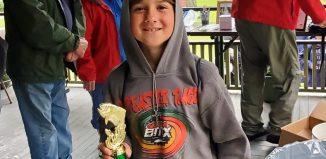Volunteers in the garden: welcome or unwelcome?

By Ellen Barcel
Many times a plant appears in the garden that the gardener didn’t plant. A weed? Perhaps, but it really helps to know what seedlings and young plants look like so that you can see if a “volunteer” is a prize or a pain.
Among the not-really-wanted plants that easily volunteer in the garden include dandelions, onion grass, garlic mustard, wineberries, multiflora roses and oriental bittersweet. While onion grass is a mild nuisance, just mow over it, garlic mustard easily grows to a foot or more in height and is really unsightly.
Wineberries are an invasive plant, related to raspberries, that can be spread by birds. The berries are definitely edible, but not nearly as tasty as raspberries. If you want raspberries, then plant them and pull out the wineberries — carefully because they have thorns.
Multiflora roses are attractive, with many (hence the term multiflora) blooms in early June borne on arching canes. Years ago, they were planted by many Long Island gardeners because of their rapid growth and dense habit. They were even sold as a living fence for cattle. But, and here’s the big but, they are extremely invasive. Like wineberries, be careful pulling them out because of the thorns.
Another volunteer that is extremely invasive is oriental bittersweet. It’s very pretty with its red berries that break open to reveal yellow seeds, but it’s definitely invasive. Lesser celandine has pretty yellow flowers in the spring but, again, is very invasive.
Note that wineberries, multiflora roses and oriental bittersweet as well as lesser celandine are all on Suffolk County’s Do Not Sell List. However, there are so many here already and they are so easily spread, especially by birds, that it’s still a battle getting rid of these invasives.
On the other hand, there are a number of volunteers that are welcome in the garden. Reseeding plants that you’ve put in the garden are wonderful. They may not be perennials but they’re almost as good. In this category includes the money plant (Lunaria) with its purple flowers and silvery seed pods.
Many years ago, a small tree planted itself in my back yard. Curious as to what it was, I left it alone and it matured into a gorgeous tree covered in pink flowers in the spring. I never did figure out what it was — there were a number of possibilities. It could have been some variety of cherry, but it never bore fruit, so I never did find out. It was a welcome volunteer and sadly missed when one spring, it became obvious that it didn’t make it through the previous harsh winter.
Another volunteer that is most welcome in my garden was also filled with pink flowers. Again, I couldn’t figure out exactly what it was until it started to produce peaches. Unfortunately, the variety were small and bitter, so I don’t use them instead allowing the local critters to dine. But, I don’t take the trees out either, because they produce nice shade and those beautiful flowers.
I’ve had rose of Sharon and holly also seed themselves in the garden, both welcome plants. On the other hand, the thistle that seeded itself by my front door, while interesting, was a danger. Tiny maple trees (Norway maple, Acer platanoides) try to take over my garden — they’re everywhere. Simply cutting them off at ground level with a pruning shears usually works, and small ones can be easily pulled out especially after a rain.
Another beneficial volunteer is clover in the lawn. It’s a nitrogen fixing plant that takes nitrogen from the air and stores it in its roots. It attracts pollinators and is low maintenance. However, many broad- spectrum weed killers will kill it, so read the label carefully of any products you consider using.
When you find any of these volunteers, remove the nasty ones, but allow some of the questionable ones to grow a while and mature so that you can figure out whether you have a bonus in the garden or not. They may provide you with a beautiful tomorrow in your garden.
An excellent book to help you identify some unknown plants and decide whether or not they’re keepers is “Weeds of the North East,” by Richard H. Uva, Joseph C. Neal and Joseph M. DiTomaso. The volume is published by Comstock Publishing, a division of Cornell University Press. It has color photos of the plant, closeups of the leaves, flowers and seeds. It’s a great resource.
Ellen Barcel is a freelance writer and master gardener. Send your gardening questions to [email protected]. To reach Cornell Cooperative Extension and its Master Gardener program, call 631-727-7850.






